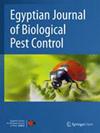一株天然平山绿僵菌感染茶象甲的鉴定及防效评价
IF 2.1
3区 农林科学
Q1 ENTOMOLOGY
引用次数: 0
摘要
摘要背景茶象甲(Myllocerinus aurolineatus Voss)是我国茶园的重要害虫。防治茶象甲的主要方法是使用化学农药。因此,迫切需要环境友好型的控制策略。为筛选对茶象甲有生物防治作用的潜在致病菌株,首次从田间采集的茶象甲侵染幼虫中分离到平山绿僵菌。结果形态特征和分子特征表明该分离株为平山分枝杆菌菌株,简称Ma0628。在22℃(茶象鼻虫化蛹温度)条件下,以1 × 10 8个分生孢子/ml的孢子悬浮液浸渍法或混土法接种平山支原体Ma0628,接种11 d后,校正后后期幼虫累计死亡率超过76%。因此,浸渍法和混土法的中位致死浓度分别为4.49 × 10.3和3.76 × 10.2孢子/ml。1 × 10 8个分生孢子/ml孢子悬浮液接种14 d后,校正后的累积成虫死亡率达到83.33%。结论平山白僵菌Ma0628菌株是一种对茶象甲幼虫和成虫均有致病性的昆虫病原真菌,可能是防治茶象甲的一种有效的生物防制剂。本文章由计算机程序翻译,如有差异,请以英文原文为准。
Identification and biocontrol potential evaluation of a naturally occurring Metarhizium pingshaense isolate infecting tea weevil Myllocerinus aurolineatus Voss (Coleoptera: Curculionidae)
Abstract Background Tea weevil, Myllocerinus aurolineatus Voss (Coleoptera: Curculionidae), is an important insect pest in Chinese tea plantations. The primary method for controlling tea weevils involves the use chemical pesticides. Hence, there is an urgent need for environmentally friendly control strategies. To screen for potential pathogenic strains useful for the biocontrol of tea weevils, a naturally occurring Metarhizium pingshaense strain was isolated from a field-collected infected tea weevil larva for the first time in China. Results Morphological features and molecular characteristics revealed the isolate was an M. pingshaense strain, herein referred to as Ma0628. At 22 °C (tea weevil pupation temperature), the inoculation with M. pingshaense Ma0628 resulted in a corrected cumulative late instar larval mortality rate exceeding 76% at 11 days after the inoculation with the 1 × 10 8 conidia/ml spore suspension using the immersion or soil-mixing method. Accordingly, the median lethal concentrations were 4.49 × 10 3 and 3.76 × 10 2 conidia/ml for the immersion and soil-mixing inoculation methods, respectively. Furthermore, the corrected cumulative adult mortality rate reached 83.33% at 14 days after the inoculation with the 1 × 10 8 conidia/ml spore suspension. Conclusion The study results indicate that M. pingshaense strain Ma0628 is an entomopathogenic fungus pathogenic to tea weevil larvae and adults, suggesting it may be a potentially useful biocontrol agent for preventing M. aurolineatus infestations.
求助全文
通过发布文献求助,成功后即可免费获取论文全文。
去求助
来源期刊
CiteScore
4.90
自引率
16.70%
发文量
128
审稿时长
>12 weeks
期刊介绍:
The Egyptian Journal of Biological Pest Control is a periodic scientific journal published by the Egyptian Society for Biological Control of Pests (ESBCP) in collaboration with SpringerNature. The journal aims to publish internationally peer-reviewed, high-quality research articles in the field of biological and integrated pest control (non-chemical control). The journal publishes review articles, original papers, conference reports, book reviews, editorials, laboratory reports, technical notes and short communications.

 求助内容:
求助内容: 应助结果提醒方式:
应助结果提醒方式:


